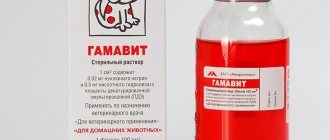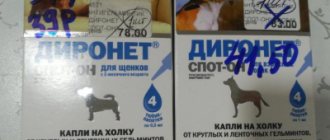Description
Stomorgyl 2 - 20 tablets.
Stomorgyl 10 - 20 tablets.
Stomorgyl 20 - 10 tablets.
Stomorgil contains spiramycin and metronidazole as active ingredients, as well as auxiliary components: aluminum hydroxide, sorbitol, white dextrin and magnesium stearate. One tablet of Stomorgil 2 contains 150,000 IU of spiramycin and 25 mg of metronidazole, Stomorgil 10 - 750,000 IU of spiramycin and 125 mg of metronidazole, Stomorgil 20 - 1,500,000 IU of spiramycin and 250 mg of metronidazole.
Dosage
The treatment regimen is determined by the veterinarian after examining the animal, test results and clarifying the diagnosis. A convenient dosage form allows you to determine the required amount of active substance depending on the weight of the animal:
- Stomorgil-2 is intended for small breed dogs, 1 table. /2 kg of animal weight;
- Stomorgyl-10 – 1 tablet/10 kg body weight, which is convenient for medium breed dogs;
- Stomorgil-20 - designed for large individuals, the dose is 1 tablet / 20 kg of weight.
The daily dose is 1 tablet; it is better to give the medicine with food or forcefully - on the root of the tongue. Having closed the dog's mouth, you need to lightly stroke the throat, this will cause a swallowing reflex.
The duration of therapy depends on the disease, the characteristics of the disease course and the presence of complications. The treatment plan is drawn up by a veterinarian. Typically, the course of antibiotic treatment is 5-10 days. Less than 5 days - treatment may be ineffective, since infectious agents are quite tenacious and able to adapt to changed conditions.
Pharmacological properties
The active components of the drug - metronidazole and spiramycin - exhibit synergistic action against a wide range of pathogenic microorganisms, including protozoa. Spiramycin, as a natural antibiotic from the group of macrolides, is capable of reversibly binding to ribosomes and suppressing protein synthesis in the microbial cell. Active against Streptococcus spp. (including Streptococcus pneumoniae), Staphylococcus aureus, Meningococcus spp., Bordetella spp., Corynebacterium spp., Listeria monocytogenes, Clostridium spp., Mycoplasma mycoides, Chlamydia spp., Leptospira interrogans, Campylobacter spp., Haemophilus spp., Bacteroides nodosus, Fusobacterium spp. and protozoa: Toxoplasma gondii. Metronidazole disrupts the respiratory processes in the cell, which causes the death of pathogenic protozoa. In addition, in some species of anaerobes it has the ability to suppress DNA synthesis and cause its destruction. Active against gram-positive anaerobes: Clostridium spp., Eubacterium spp., Helicobacter pylori and gram-negative bacteroids and fusobacteria, as well as the protozoa Trichomonas. When administered orally, the drug is well absorbed from the gastrointestinal tract (bioavailability is about 100%) and the maximum concentration of its components in the blood is observed after 1.5 - 3 hours. In terms of the degree of impact on the body of warm-blooded animals, the drug is classified as a low-hazard substance and in recommended doses does not have a resorptive-toxic, mutagenic or sensitizing effect.
Features of application
It is necessary to take antibiotics at regular intervals, at the same time every day. Skipping a dose will negatively affect the effectiveness of treatment. If you fail to give the pill on time, you need to try to do it as soon as possible, and then return to your previous dosing schedule.
Follow us
Find out more about your animal's personality on our social networks
If it is necessary to use an antibiotic to treat pregnant and lactating females, the veterinarian must assess the risks for the offspring and the dog itself, only after which a choice is made in favor of one drug or another. The same applies to the treatment of animals with chronic pathologies of the kidneys, heart, and liver. In this case, therapy is carried out under the supervision of a veterinarian.
Antibiotics should not be given:
- simultaneously with other antibacterial drugs of the macrolide group;
- with medications containing alcohol.
Contraindications and side effects of Stomorgyl
When using Stomorgil according to its instructions, there are usually no complications or side effects.
A contraindication to treatment with Stomorgyl is individual hypersensitivity to the components of the drug, including those previously identified.
For cats with decompensated liver, kidney and cardiac function, Stomorgyl therapy is carried out under the supervision of the treating veterinarian.
If the dosage regimen is violated, an overdose may occur, the symptoms of which are:
- oppression;
- salivation;
- indigestion.
If an allergy to the drug occurs, treatment with Stomorgyl is interrupted, symptomatic therapy is used, as well as an antihistamine (Pipolfen, Tavegil).
Stomorgyl can be prescribed to a pregnant cat for health reasons
Security
When using the medication, you must follow hygienic standards and personal safety rules, as when working with any veterinary products.
People with extreme sensitivity to the drug should avoid touching the drug. Do not smoke, eat or drink while working with the medicine. After completing the procedure, you should wash off the remaining substance from your hands with soapy warm water.
If you have symptoms of an allergy or unintentionally ingested the medicine into your body, you should immediately go to the doctors, taking with you the box of the medicine or the accompanying instructions.
The packaging material cannot be used in everyday life. The drug box should be wrapped in plastic film and disposed of with household waste.
Restrictions
An antibacterial agent is not prescribed:
- with individual intolerance;
- at an early age for puppies - up to 2 months;
- during periods of pregnancy and lactation.
With increased sensitivity, itching, redness of the skin, and impaired digestive function may occur. Such symptoms should be reported to your veterinarian, who will prescribe antihistamines and symptomatic therapy.
In case of an overdose, the animal may experience the following symptoms:
- stomach upset;
- nausea, vomiting;
- increased salivation;
- lethargy, depressed state.
Such signs require an immediate visit to the veterinary clinic, where the pet’s stomach will be rinsed and symptomatic treatment will be prescribed.
Stomorgil
Instructions for use of the drug Stomorgil 2, 10 and 20 for the treatment of infections of bacterial etiology in dogs and cats (developer organization, France)
I. General information Trade name of the drug: Stomorgyl 2, 10, 20 (Stomorgyl 2, 10, 20). International nonproprietary name: spiramycin and metronidazole.
Dosage form: tablets. The drug as active ingredients, depending on the dosage, respectively contains:
- Stomorgyl 2 (120 mg tablet) - spiramycin 150,000 IU and metronidazole 25 mg;
- Stomorgyl 10 (tablet weighing 600 mg) - spiramycin 750,000 IU and metronidazole 125 mg;
- Stomorgil 20 (tablet weighing 1200 mg) - spiramycin 1,500,000 IU and metronidazole 250 mg;
as well as auxiliary components: aluminum hydroxide - 4%, sorbitol - 2%, white dextrin - 0.15%, gelatin - 0.25%, magnesium stearate - 1% and starch - up to 100%.
The drug is released in blisters packed in cardboard boxes.
Store the drug in the manufacturer's sealed packaging, separate from food and feed, in a dry place, protected from direct sunlight, at a temperature from 0°C to 25°C. The shelf life of the medicinal product, subject to storage conditions, is 3 years from the date of production. It is prohibited to use Stomorgil 2, 10, 20 after the expiration date.
Stomorgyl 2, 10, 20 should be stored out of the reach of children.
Unused medicinal product is disposed of in accordance with legal requirements.
II. Pharmacological properties Stomorgil 2, 10, 20 refers to combined antibacterial drugs. Thanks to the combination of its active components, it has a wide spectrum of action against gram-positive and gram-negative microorganisms.
Spiramycin is an antibiotic of the macrolide group; it has bacteriostatic activity, reversibly binding to the 50S ribosomal subunit, and inhibits protein synthesis in the microbial cell. Active against gram-positive and some gram-negative microorganisms, including Staphylococcus spp., Streptococcus spp., Clostridium spp., Corynebacterium, Actinomyces, Bacteroides and Mycoplasma spp.
When administered orally, it is quickly adsorbed in the gastrointestinal tract and diffuses well into biological fluids (including saliva), organs and tissues. The maximum concentration of spiramycin in blood plasma is observed after 4-6 hours, in saliva - after 4-8 hours.
Metronidazole is an antiprotozoal agent from the nitro-5-imidazole group. Active against anaerobic microorganisms, including Bacteroides spp., Clostridium spp., Fusobacterium, suppresses the development of protozoa, including balantidia, trichomonas, lamblia and amoebae. After oral administration, metronidazole is rapidly and almost completely absorbed from the gastrointestinal tract, reaching maximum concentrations in plasma and saliva after 1 hour. Metabolism occurs in the liver by oxidation and binding to glucuronic acid.
Stomorgyl is used to treat infections caused by staphylococcus, streptococcus, and clostridia. Stomorgyl is also effective in the treatment of mycoplasmosis in cats and dogs, trichomoniasis, amebiasis, giardiasis and other protozoal diseases.
The active components of the drug are excreted from the body mainly with urine and partly with feces, and in lactating animals also with milk.
In terms of the degree of impact on the body, Stomorgyl 2, 10, 20 belongs to moderately dangerous substances (hazard class 3 according to GOST 12.1.007-76), in recommended doses it does not have a sensitizing, teratogenic or embryotoxic effect.
III. Directions for use Stomorgyl 2, 10, 20 is prescribed to dogs and cats for the treatment of bacterial infections caused by microorganisms sensitive to metronidazole and spiramycin, and primarily infections of the oral cavity, including periodontal diseases, stomatitis, gingivitis and pyorrhea.
A contraindication for use is the animal’s hypersensitivity to the components of the drug (including a history of it). Animals with severe heart, kidney and liver diseases should use the drug with caution under the supervision of a veterinarian.
Stomorgyl 2, 10, 20 is administered to dogs and cats individually orally once a day at a dose of 75,000 IU of spiramycin and 12.5 mg of metronidazole (active ingredients) per 1 kg of animal weight, based on:
- 1 tablet of Stomorgil 2 - per 2 kg of animal weight;
- 1 tablet of Stomorgil 10 - per 10 kg of animal weight;
- 1 tablet of Stomorgil 20 - per 20 kg of animal weight.
The duration of treatment, depending on the condition of the animal, is 5-10 days and is determined by the attending veterinarian.
Tablets of the drug should not be used in crushed form; the tablet may be divided into parts only according to the mark on it.
In case of an overdose, animals may experience excessive salivation, gastrointestinal upset, and a depressed state.
No peculiarities of action were identified during the first use of the drug and when it was discontinued.
If you miss another dose of the drug, the course of use must be resumed as quickly as possible at the same dose according to the same regimen.
Side effects and complications in animals when using the drug in accordance with these instructions, as a rule, are not observed. If allergic reactions occur in an animal sensitive to the components of the drug, its use is stopped and antihistamines and symptomatic drugs are prescribed.
Stomorgyl 2, 10, 20 should not be used simultaneously with other macrolide antibiotics.
Stomorgyl 2, 10, 20 is not intended for use in productive animals.
Reviews
Owners
Larisa, 37 years old, Irkutsk : “Our dog is already old and does not like solid food, which mechanically cleans his teeth. As a result of the lack of such hygiene procedures, the dog developed gingivitis. The veterinarian prescribed a topical remedy and Stomorgyl tablets. The pet was treated for 10 days. All unpleasant symptoms have passed. The dog is healthy and cheerful again.”
Tatyana, 31 years old, Rostov-on-Don : “We recently picked up a pathetic little dog on the street. They began to fatten her up, but she ate poorly. The gums were black and there was an unpleasant odor coming from the mouth. The vet prescribed Stomorgyl and a spray. Improvements were noticed on the 4th day of treatment. Gradually the dog began to eat and gain weight.”
Marina, 44 years old, Krasnoyarsk : “Our toy has a problem - his mouth cavity often becomes inflamed. During periods of exacerbation we give Stomorgyl. The dog is recovering quickly. It is a pity that the drug does not cure the disease, although doctors cannot find out the cause of the pathology. The drug is effective, but it is expensive, especially for those owners who have large dogs.”
Veterinarians
Victor, 57 years old, veterinarian, Chita : “Stomorgyl is an effective antibiotic. I often use it for diseases caused by bacteria. The price is high, but the result is good. There are almost no side effects, but I warn dog owners that they must follow the doctor’s recommendations and adhere to the prescribed dosage.”
Sergey, 28 years old, veterinarian, Omsk : “An effective and safe antibiotic. I prescribe it for diseases of the mouth cavity caused by bacteria. Dog and cat owners do not complain about side effects. If painful symptoms appear, this is due to improper use of the medicine or an allergy to the drug.”
Composition and expiration date
The drug is created on the basis of 2 active components - spiramycin (an antibiotic belonging to the group of macrolides) and metronidazole, which kills protozoan microorganisms and a number of bacteria. The composition of the drug is supplemented with sorbitol, magnesium, starch, etc.
The drug is offered in the form of oral tablets in 3 dosages:
| Type of drug | Dosage | |
| Spiramycin (IU) | Metronidazole (mg) | |
| Stomorgyl-2 – 120 mg | 150000 | 25 |
| Stomorgyl-10 – 600 mg | 750000 | 125 |
| Stomorgyl-20 – 1200 mg | 1500000 | 250 |
To preserve the pharmacological properties, the drug should be stored correctly:
- storage place - dry, protected from daylight;
- Ambient air temperature – +0…+25°C.
If these conditions are met, the tablets will be usable for 3 years. The countdown starts from the date indicated on the packaging.
Storage conditions and cost
The drug must be stored in a dark place where the sun's rays will not fall on it at a temperature of +5 to +25. If more than 3 years have passed since the date of release of the medicine or storage conditions have not been met, it cannot be used. Store the medication at a relative humidity of no more than 50% in the package. It should not be placed near food or in a place accessible to children and animals. Stomorgyl is a powerful antibiotic that effectively fights a large number of bacteria, but at the same time has a gentle effect on the body. The product is quite expensive (the price varies depending on the dosage). On average it is 600-1400 rubles. But many cat owners who have used it note its effectiveness in alleviating the animal’s condition.
How to give a pill to a cat
Visit the profile section of our Medical Examination forum or leave your feedback in the comments below. More opinions means more useful information, it will be useful to someone. If there are good and interesting videos on the topic of the article, write and I will insert them into this publication.
Analogs
Stomorgil has no complete analogues. Intramycin instead .
It is available in the form of an injection suspension. Some people find this dosage form more acceptable, because tablets are difficult to give to dogs. But not every owner has the special skills to inject a pet.
Intramycin is cheaper than Stomorgil - about 600 rubles. per bottle of 100 ml.
Stomorgyl is an effective veterinary remedy. The only downside is the high price. But the result of therapy justifies the means. It is not recommended to use the medicine without consulting a doctor.











